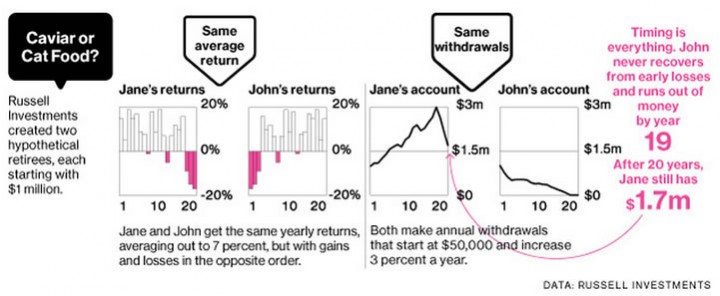 One of the first things that pops up when doing research on retirement annuities is the “annuity puzzle”. Essentially, economists have done their calculations and shown that simple, immediate income annuities are theoretically the best fit for many people. You give up some things like liquidity and upside potential, but in exchange you get the most monthly income for the rest of your life. But in the real world, only a small fraction of such people actually go out and buy such annuities.
One of the first things that pops up when doing research on retirement annuities is the “annuity puzzle”. Essentially, economists have done their calculations and shown that simple, immediate income annuities are theoretically the best fit for many people. You give up some things like liquidity and upside potential, but in exchange you get the most monthly income for the rest of your life. But in the real world, only a small fraction of such people actually go out and buy such annuities.
Bob Seawright wrote a nice article at ThinkAdvisor.com that lists three main risks with managing withdrawals from your own lump-sum portfolios. An income annuity can help address these risks. I’ve added my own comments as well.
Longevity risk. People are living longer on average. Enter your age(s) into this Vanguard longevity tool. Here is a short snippet from a previous longevity risk post:
For an individual that is 65 today, there is roughly a 50/50 chance they will reach age 80. For a couple both at 65, roughly a 50/50 chance that at least one person will reach age 90.
The extreme ages are getting higher as well; quote below taken from the Seawright post:
Moreover, the distribution of longevity is wide — a 22-year difference between the 10th and 90th percentiles of the distribution for men (dying at 70 versus 92) and a 23-year difference between the 10th and 90th percentiles of the distribution for women (dying at 72 versus 95).
Sequence of returns risk. Two retirees can start with the same initial portfolio balance and experience the same average return, but if one experiences highly negative returns in the first few years of withdrawals they can end up with very different outcomes. Here is a previous graphic illustrating the sequence of returns risk.

Stupidity risk. If you do-it-yourself, what if you aren’t very good? The idea of safe withdrawal rates is a starting point, but even that assumes a theoretical 60/40 you-didn’t-panic-when-stocks-dropped-50-percent portfolio. I like the idea of adding some robustness with more flexible dynamic safe withdrawal rates, but “safe” is still a relative term.
Eventually, I plan to put a portion of my money into a single premium immediate annuity (SPIA). I’ll probably wait until around age 65, with a joint life rider so that it will keep paying out as long as either my wife or I are alive. I like the idea of having enough guaranteed income to cover all basic needs like housing, food, and utilities. Considering that we have no mortgage and assuming no major cuts to Social Security, I am hoping that number is not too much in excess of state-specific insurance guaranty coverage limits.
 The Best Credit Card Bonus Offers – March 2024
The Best Credit Card Bonus Offers – March 2024 Big List of Free Stocks from Brokerage Apps
Big List of Free Stocks from Brokerage Apps Best Interest Rates on Cash - March 2024
Best Interest Rates on Cash - March 2024 Free Credit Scores x 3 + Free Credit Monitoring
Free Credit Scores x 3 + Free Credit Monitoring Best No Fee 0% APR Balance Transfer Offers
Best No Fee 0% APR Balance Transfer Offers Little-Known Cellular Data Plans That Can Save Big Money
Little-Known Cellular Data Plans That Can Save Big Money How To Haggle Your Cable or Direct TV Bill
How To Haggle Your Cable or Direct TV Bill Big List of Free Consumer Data Reports (Credit, Rent, Work)
Big List of Free Consumer Data Reports (Credit, Rent, Work)
This is interesting. Immediate annuities, like term life insurance, are a good way to diversify away your mortality risk (or longevity risk if you prefer). Also similar to term, they tend to be commodity-like products that are transparent and competitively priced.
You could create your own immediate annuity using a ladder of high quality bonds IF you knew exactly when you would die. Essentially that is what the insurance company is doing, except for a population of participants, so they can use the law of large numbers to probabilisticly estimate accurately when the population they are insuring will die.
I would be concerned with buying an immediate annuity right now, as they are priced based on bond yields and you could get a lot more lifetime income in a more normal interest rate environment.
Separately, aren’t there deferred lifetime annuities? In other words, couldn’t you purchase today an income annuity that starts when you are age 65, and pay considerably less for it than if you waited (ignoring shifts in the yield curve)? Could be an interesting option.
Good points and questions – I am currently researching deferred annuities that would start the monthly payments at say age 59.5 or 65, but until then would accumulate in a tax-deferred manner. There are fixed annuities that have multi-year guarantees that act similar to bank CDs, for example right now you might get a 5-year rate guarantee at 3%. There are multiple differences to consider though, like you have an insurance company guarantee instead of FDIC insurance. Still, the additional tax-deferred space is very interesting to me.
I will have a pension, along with a 403B and Social Security. Is my pension like an annuity of sorts, in that, it will provide a regular monthly payment for life? The amount of the pension is about twice my typical living expenses.
Yes, a pension that provides guaranteed monthly income payments would be similar to an annuity. The topic of concern is that many pensions now offer a lump-sum payout as an alternative option.
Another advantage of SPIA is mortatlity credits. So you get a higher payout compared to DIY bond ladders